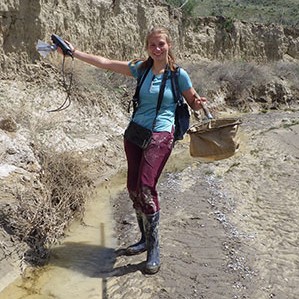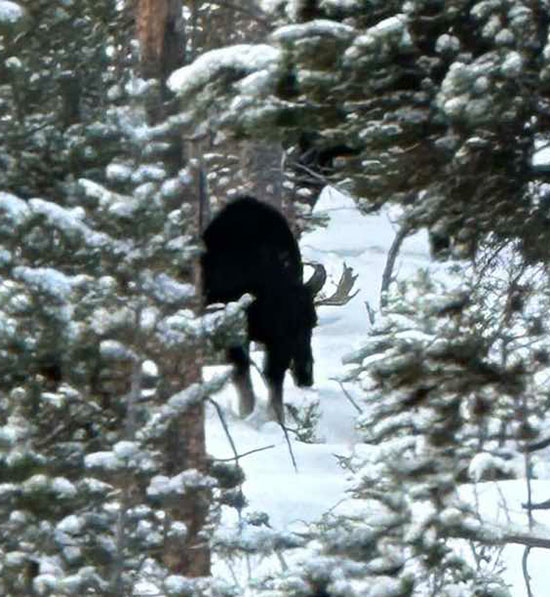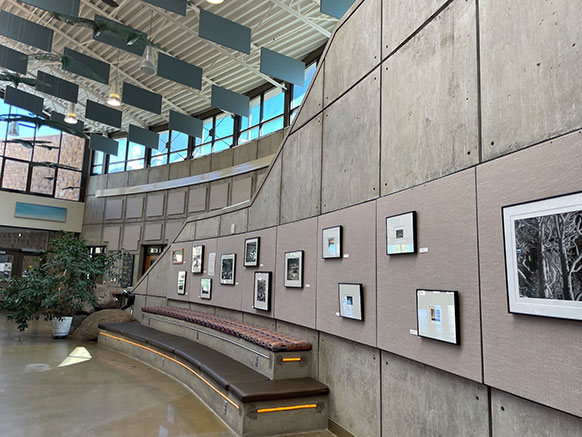No Slides Entered.
UW Grad Student Wins Regional Honor for Beetle Research
A University of Wyoming graduate student has been honored for her research showing that, among other things, a rare aquatic beetle in central Wyoming is found in more streams than had been documented previously.
Audrey Lindsteadt is the winner of the 2024 Rocky Mountains Cooperative Ecosystem Studies Unit (RM-CESU) Student Award, which recognizes outstanding accomplishment by students at institutions in states including Colorado, Idaho, Montana, Utah and Washington, as well as Alberta, Canada.
Lindsteadt, now a Ph.D. student in UW’s Program in Ecology and Evolutionary Biology, completed the beetle research as a master’s degree student in the Department of Zoology and Physiology.
“Audrey is talented, engaged, devoted and a curious scientist with a strong work ethic and outside-the-box thinking. Although Audrey’s research focused on a rare beetle in harsh conditions, her results provide a new take on rare species management, which she is shaping into a new paradigm that managers can use for rare animals living in specialized or harsh habitats,” wrote Lusha Tronstad, the lead invertebrate zoologist in UW’s Wyoming Natural Diversity Database who was Lindsteadt’s adviser. “Audrey is an amazing student with fresh insights, unique interests and unparalleled abilities that will contribute to her success in her education and beyond.”
Lindsteadt found that the narrow-foot Hygrotus diving beetle, previously only known in 16 salty streams in central Wyoming, exists in three additional streams in two new watersheds, including the Big Horn Basin. That information informed the U.S. Fish and Wildlife Service’s 2023 decision to not list the beetle for protection under the federal Endangered Species Act (ESA).
“I believe Ms. Lindsteadt’s information was critical to many facets of my agency’s species status assessment, including our evaluation of its life history, physiological tolerances and range,” wrote Julie Reeves, a former biologist for the Fish and Wildlife Service’s Wyoming Ecological Services Field Office. “Without the information from Ms. Lindsteadt and our partnership with (UW’s) Wyoming Natural Diversity Database, the (Fish and Wildlife) Service would not have been able to fully understand the resiliency, redundancy and representation of the narrow-foot Hygrotus diving beetle, and would not have been able to determine its current or estimate its future viability, ultimately leading to our decision that the species does not warrant protection under the ESA.”
The narrow-foot Hygrotus diving beetle was discovered in 1964. The small insect inhabits intermittent streams and ephemeral pools with high concentrations of dissolved salts. It feeds on larval mosquitos, midges and other insects. Lindsteadt found that the beetles choose to live in streams where they have a high likelihood of dying, likely because there is less competition from other insects -- not because they’re adapted to the harsh conditions.
“Information from Audrey’s project is changing the way we should think about and manage endemic species,” Tronstad wrote. “Audrey’s results provide a framework to base other studies of rare species that live in harsh environments. Such species are critically important ecologically and monetarily because they are frequently petitioned for Endangered Species Act listing.”
Lindsteadt came to UW after completing her bachelor’s degree in biology at Missouri Western State University.
Share This Post

Audrey Lindsteadt takes a break from collecting narrow-foot Hygrotus diving beetles in Dugout Creek, near Midwest in central Wyoming, where the insect species was first discovered in 1964. Lindsteadt is the winner of the 2024 Rocky Mountains Cooperative Ecosystem Studies Unit Student Award. (Lusha Tronstad Photo)
Social Media
Latest News



Archives
- All
- December 2025
- October 2025
- August 2025
- July 2025
- June 2025
- May 2025
- April 2025
- March 2025
- February 2025
- January 2025
- November 2024
- October 2024
- September 2024
- August 2024
- July 2024
- June 2024
- May 2024
- April 2024
- March 2024
- February 2024
- January 2024
- December 2023
- November 2023
- August 2023
- July 2023
- April 2023
- September 2022
- August 2022
- July 2022
- June 2022
- May 2022
- April 2022
- March 2022
- February 2022
- January 2022
- December 2021
- November 2021
- October 2021
- September 2021
- August 2021
- May 2021
- April 2021
- March 2021
- October 2020
- August 2020
- July 2020
- January 2020
- March 2019

